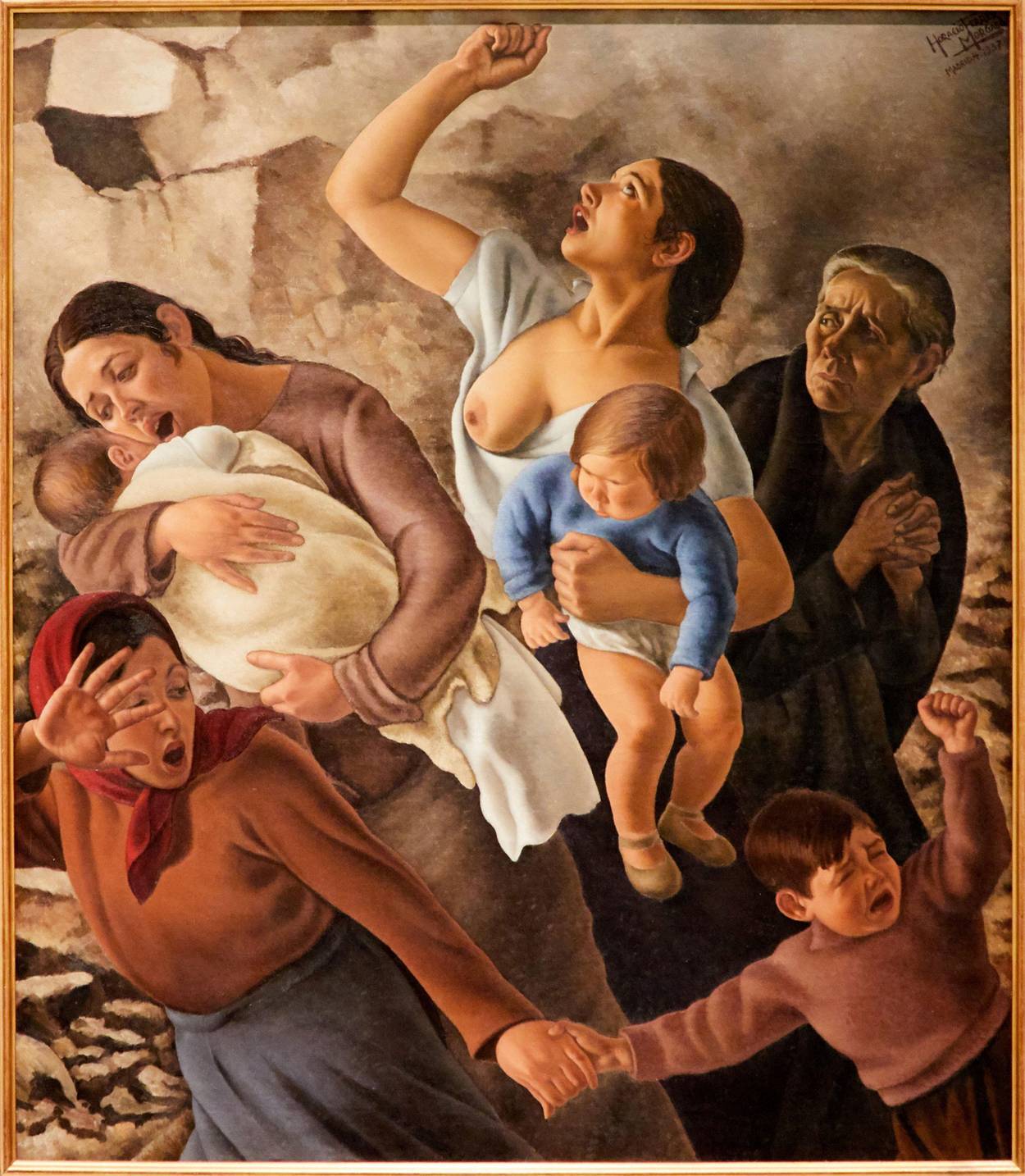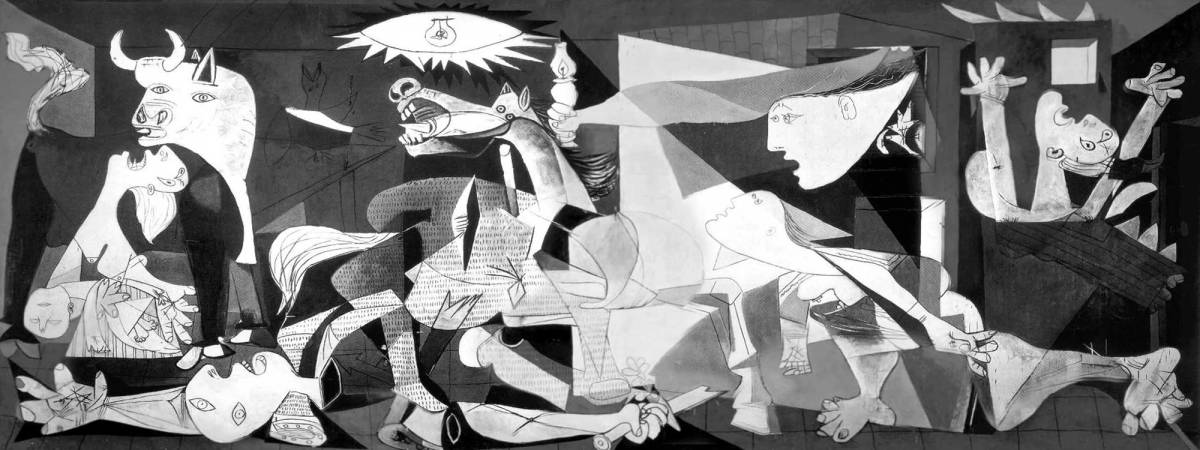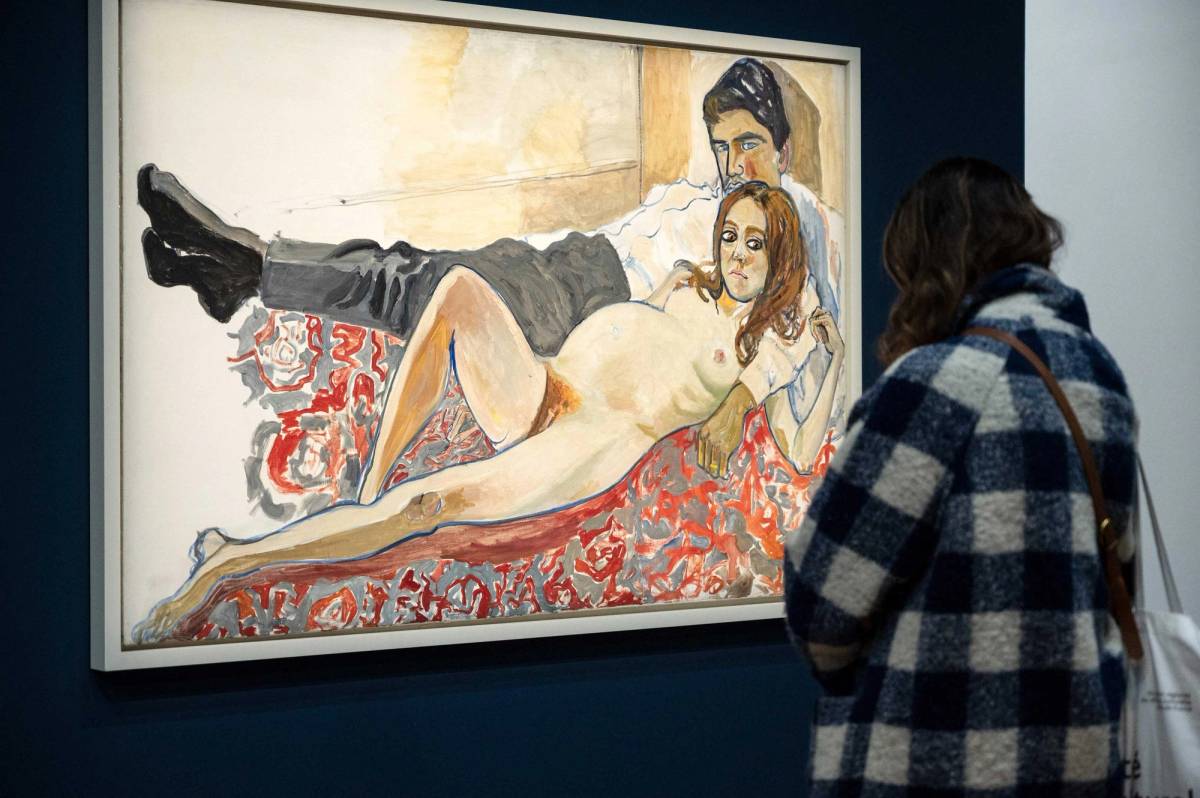Why Good Politics Makes for Bad Art
Affirmation is available everywhere. Why ruin aesthetics?

Museo Nacional Centro de Arte Reina Sofía

Museo Nacional Centro de Arte Reina Sofía

Museo Nacional Centro de Arte Reina Sofía

Museo Nacional Centro de Arte Reina Sofía
Intrinsically, there are no subject matters unsuitable for art. For art this is forever true; for artists, in practice, it has been a truth granted only very recently, certainly for less than 200 years, and not always without incident. Still: In the West today, the charge of prescriptivism—what to commit to as one’s subjects, eschewing all the infinite others—falls to the individual artist, rather than some named or nameless authority. The granting of this universal truth, an extraordinary thing historically, has not simplified the plight of artists.
When Horacio Ferrer de Morgado approached the canvas on which he would paint the work he titled “Madrid 1937 (Black Aeroplanes),” his subject allowed for no obscurity. The painted figures, four women and three children against a background of rubble and smoke, would be life-size. Because the artist was then working in the style of social realism, his scene of war could not blatantly include General Franco looming as perpetrator. But symbolic details that Ferrer incorporated—the communist-red scarf around the head of one woman, the raised fist of another, in the defiant salute of the Republic—made clear who were the terrorized victims he depicted. At the opening of the 1937 Paris World’s Fair, one year into the Civil War in Spain, the painting was first presented to the public. It was, a Republican government administrator back in Madrid heard, the Spanish pavilion’s “greatest popular success.”
Who reading this knows the painting? Who has looked at it, in person or in reproduction, for those long minutes in which time stops? Not “Madrid 1937” but “Guernica” is the enduring artwork of the Spanish Civil War, and probably the most celebrated antiwar painting of the century. On the ground floor of the Spanish pavilion, one floor below the gallery containing Ferrer’s work, Picasso’s was the only painting hung. How odd it seems to us now that on being unveiled, “Guernica” was condemned by Spanish loyalists as insufficiently political—too indirect and ambiguous. One group called for its removal and the mounting of “Madrid 1937” in its place. Another group demanded it be replaced with a painting of dead children.
The politics of Ferrer’s and Picasso’s paintings are of course not dissimilar. If the realist work seems to us, at once, less caustic or damning, and at the same time, plainly didactic, our evaluation is at odds with its contemporary audiences’, for whom “Madrid 1937” was more powerful because more politically defiant. Where, for us, the conflation of immense visual coherence in “Guernica”—a scene illuminated as though by the flash of an explosion—with narrative incoherence—carnage the common element among its unrelated figures—generates upon the viewer an assault both moral and aesthetic, many in Paris found the painting difficult, challenging in a way they wished not to be challenged. Its ambiguity offended. Conversely, the designed-by-committee quality of Ferrer’s painting pleased antiwar audiences. They did not want an aesthetic assault.

Alamy
We struggle to know, unless we are Ukrainian, the urgency felt then by the Spanish people. Franco’s Nationalist army had captured cities from Málaga in the south up through Seville and, now with the aid of its Nazi and Fascist allies, Bilbao and much of the Basque country. What are aesthetics when one is living in wartime?
Writing on the World’s Fair in The Spectator, a British art historian articulated a common view of the painting when he called Picasso’s work “not an act of public mourning but the expression of a private brain-storm.” The characterization was meant negatively, the review highly critical. Months later in the magazine, the writer reiterated his point—that “Picasso’s art is a highly specialized product, an essentially private art, which is therefore not easily applied to public problems.” Ironically, this is an accurate evaluation of “Guernica,” a painting so powerful for the very reason that it is a fully private expression, a vision no one’s but Picasso’s.
A great many working artists choose in their art to address “public problems.” One difficulty is that, unlike in a time of civil war, the political issues of our day are not straightforwardly, collectively, diagnosable. If we were in want of consensus on how best to confront our problems—if it were merely solutions that eluded us—our society would be unrecognizable. It would be functional. We might thrash ideas out. But no: The economy, our social mores, freedoms of speech and association, criminal justice, the global climate, are all areas afflicted by crises whose natures are diagnosed by different groups in impossibly antithetical ways.
So fierce are disagreements over our public problems that the simple statement “such and such is wrong,” the simple outlining of a problem, rather than a proposal for how it might be responsibly tackled, strikes many as good politics. Hearing the statement, we feel we are not alone, going mad. Those crises that impact or trouble us exist not only in our heads. They are concrete.
Rarely are the politics of an artwork, even when it addresses political matters directly, any more penetrating than the statement of a problem. Rarely does art treat political subjects with the complexity found even in quality journalism. Expecting artists to contend with social scientific data, to carry out the work of think tanks or propose legislation, would be silly. Instead, what political art does proffer is the experience of recognition. For many, finding in art an expression of their political concerns asserted in a voice not their own can be terribly affecting, because it is validating.
For those of us not needing our political attitudes affirmed by art—for those of us who live without such insecurity—we turn to artworks for other reasons, reasons unknown to us until a work takes us in. Affirmation is available everywhere. Why look for it in art, when what the most valuable works offer up exists nowhere else?
Affirmation is available everywhere. Why look for it in art, when what the most valuable works offer up exists nowhere else?
Whereas politics attend to concrete social matters, every great work of art is itself the manifest solution to a totally invented problem. Only in the artist’s psyche was the problem ever real. No artwork ever had to exist, nor be made to exist as it was. This is true even of commissioned art, when significant. Every treatment of every subject demands its own form. As phenomena born of the aesthetic imagination, artworks are complete when the artist knows so—not upon reaching a certain word count or run time, not at the moment the canvas has been filled or materials used up. (Automatic and constraint-based methods necessarily yield lots of dreck because of this.) The artist alone recognizes when a work has attained the state of completion, when it has been realized as a singular solution bound up in its problem.
“All art is political,” a notion with which we are bludgeoned, derives from two facts of formidable substance: that (i) artworks are produced by and exist for people, and that (ii) wherever there are people, there are politics. Gut bacteria also are present wherever there are people, though are we advised less frequently to seek in poems and sculptures hard truths about the microbiome. Toni Morrison, a superlative artist, endorsed the notion in the way it is most typically pronounced. From a 2008 interview:
Are you really telling me that Shakespeare and Aeschylus weren’t writing about kings? All good art is political! There is none that isn’t. And the ones that try hard not to be political are political by saying, “We love the status quo.” We’ve just dirtied the word “politics,” made it sound like it’s unpatriotic or something. ... My point is that it has to be both: beautiful and political at the same time. I’m not interested in art that is not in the world.
By “art ... in the world,” I take her to mean art concerned with social relations, which regretfully fails to encompass all sorts of works of both nonrepresentational and nonnarrative art. It is to the detriment of all who revere Morrison that the interviewer did not follow up with the question of whether Monet’s waterlilies, as examples of “good art,” are political. Possibly Morrison did not care for those paintings. Monet’s plants had been imported from Egypt and South America; maybe, though I can hardly imagine it, she would have something to say about the politics of the late 19th-century botanical trade.
Morrison’s distinction between political and apolitical (and thus status quo-loving) art is puzzling, especially when coupled with the artists she cites. If (falsely) apolitical art upholds the status quo, does it stand that overtly political art always challenges it? Or is it possible for “good art,” which for her is always substantively political, to explicitly align with the status quo? Shakespeare’s plays are immeasurably rich, but in them we do not find a great variety of attitudes regarding the necessity of social order, social hierarchy, and stable institutions. His plays certainly did not challenge the status quo of the royal court. The Oresteia culminates in the establishment by Athena of a new legal system in which justice is achieved through jury trial. Without the judicial system under which Aeschylus’ audience was living, his trilogy demonstrates, the curse on the House of Atreus—the cycle of violence—would never have broken. The plays positively champion the status quo.
At their most commanding, Morrison’s novels share with the works of both playwrights not some political nature but the quality of profound moral seriousness. The contradictions within a society’s ethical system; the brutal arbitrariness of what behaviors a society deems acceptable; morality’s confounding inconstancy; its elusiveness; the gap into which one whose moral code misaligns with society’s ethics may fall; acts of judgment and cowardice that ripple through time: Of all art forms, fiction is especially well-suited to exploring these issues and their implications for the individual human life. Any appreciation of an artwork is cheapened, not enriched, by imprecisely claiming as political what are moral and social issues.
With important artists on record stating that all good art is political, naturally people throughout the culture will themselves insist on the notion in an effort to have them and their output appear more serious than they are. When presented as forthrightly political, commercial products transmogrify, instantly, into works of art. Here is how the entertainer Lin-Manuel Miranda opened “What Art Can Do,” a 2019 magazine article: “All art is political. ... Art lives in the world, and we exist in the world, and we cannot create honest work about the world in which we live without reflecting it.” He goes on, in no less bracing prose, to explain that his forthcoming film is about immigrants, who indeed live in the world, and that some immigrants have been demonized. Present political conditions, Miranda writes, have made his story a “radical narrative.” Today, “for some, considering an immigrant a human being is a radical political act.”
No doubt emptier statements than this have been printed in The Atlantic, but its meaninglessness in the context of contemporary American life is worth observing. It is a farce to imagine that artworks about the plight of immigrants in any way help attend to the material problems of how the nation’s immigration and asylum systems are to be run. The number of people worldwide wanting to move to the United States was 160 million on last count. Should all be welcome here? May they arrive tomorrow? What resources will be apportioned to support the poor, the helpless, and the sick among them? Will working class wages be affected, and do we care? Are there jobs and schools and housing enough for the new arrivals? If there are not, what is to be done so that each immigrant is not merely considered a human being, terribly radical though this act is, but capable of living decently as one? Artworks sold as politically radical allow the purchasing public to indulge their concerns in the bloodless realm of abstraction. Along with a ticket to one of Miranda’s productions, they buy the lie that to attend is the height of civic responsibility.
If there is a tangible effect on our politics resulting from artworks and entertainment products such as Miranda’s, it is in their degrading of the political discourse. Politics are more infantilized, tribal, performative, and symbolic because of such works. Their overall political effect is in all directions negative.
The pull of art is older within us than are the demands of politics, older than states or cities or settled communities. Politics are a consequence of our living in societies, which we have not always done. Even if one believes the story told by David Graeber and David Wengrow, that humans have exhibited “political self-consciousness” since before the invention of agriculture, perhaps 30,000 years ago, by their reckoning—even if one accepts all that, our earliest known artworks still precede our political selves by tens of thousands of years. Far longer have humans been making symbolic visual marks, adorning themselves, making music, even making figurative art. (We know our human relatives and ancestors were engraving and painting and playing instruments earlier still.) Our aesthetic temperament exists autonomously, deeply, within us. We make art because we can, because the Muses insist, because we have the will to do so.
To discern that the relation of art and politics is incidental, not inherent, is hardly to underestimate art’s power. Rather, claiming everything human is political is an underestimation of the human.
How much easier the task of publicizing artists and their works is during a time of political art’s ascendance. Compared with politics, aesthetics are wretchedly difficult to promote. The marketing copy about political art writes itself.
A recent major museum retrospective was advertised as a survey of “one of the century’s most radical painters, a champion of social justice whose longstanding commitment to humanist principles inspired her life as well as her art.” Within Alice Neel’s large body of work are scenes of privation, social inequality, political protest, and sexual liberation. Her portrait subjects included the civil rights leader James Farmer, labor organizers, and left-wing activists, among other political figures. Understandably, given that much of her art addressed political issues, the show’s curators foregrounded the politics of both the painter and her subjects. Writing in The New York Review of Books, Susan Tallman offered a different assessment of what motivated Neel, something other than her “humanist principles”:

Bertrand Guay/AFP via Getty Images
These are great paintings for the same reasons that the Bronzinos are great paintings—they have been put together by someone relentlessly interested in the surfaces of the world. Neel’s fascination with painting naked pregnant women may have been driven by the socially conscious desire to record female experience, but what she said was, “Plastically [pregnancy] is very exciting.”
Outwardly, Neel’s subjects are political—the contents of her paintings are political subjects—but the substance of her art—what her paintings address—is, more precisely, how “the surfaces of the world” can find expression in paint. This fact of Neel’s work extends to other art forms. Poems are ostensibly about particular subjects, but their substance is their language, the words and the effect of what has been done with them. An artwork’s aesthetics are not its exterior but interior, not its surface but its depths. This truth is perhaps more obvious with the performing arts: Music’s genuine subject is sound; how the dancers’ bodies move through space is always the subject of a dance.
If in recent decades the artworks that influential people have heralded—the works receiving promotion, glowing write-ups, and major awards—seem unlikely to be found meaningful by audiences even a decade from now, it is not so much because certain subjects have been overrepresented. More broadly, the arts suffer because they have been overtaken by a perversion of the democratic spirit. Political art has been prominent; derivative, pedantic, unambitious, historically ignorant, shallow, designed-by-committee art has been more prominent still. Great artworks may or may not be difficult but are always ruthlessly singular expressions, their nature aristocratic. A culture valuing inclusion above all else will never know its masterpieces.
Alice Gribbin is a poet and essayist. Her writing on literature and the visual arts appears at alicegribbin.substack.com.